From a GST hike to CDC vouchers: 9 things you need to know about Budget 2022
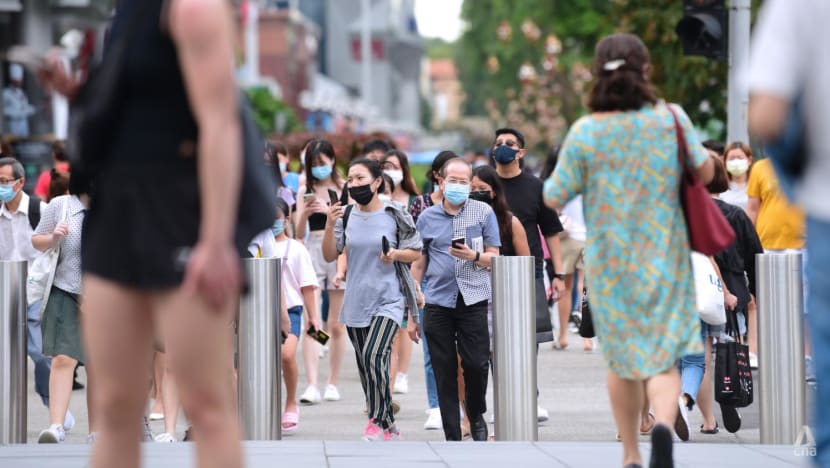
People wearing protective face masks in Orchard in Singapore on Jan 5, 2022. (Photo: CNA/Gaya Chandramohan)
SINGAPORE: An anticipated hike in the Goods and Service Tax (GST), as well as higher CPF contributions for older workers, were among the key announcements by Finance Minister Lawrence Wong in his Budget 2022 speech on Friday (Feb 18).
Delivering his first Budget statement, with the theme “charting our new way forward together", Mr Wong emphasised a renewal of the social compact among individuals, community groups, employers and the Government.
Singapore's measures over the past two years to support Singaporeans and businesses have seen results, he said.
“We are moving forward from a position of strength. Our responses to the pandemic have distinguished us from other countries,” he added.
Here are nine key takeaways from Budget 2022:
GST HIKE DELAYED TO 2023
The GST hike will be delayed to next year and implemented in two phases.
First, it will go up from 7 per cent to 8 per cent on Jan 1, 2023, and then to 9 per cent on Jan 1, 2024.
To cushion the impact, the Government will provide an additional top-up of S$640 million to the S$6 billion Assurance Package, giving "significant payouts" to Singaporeans, said Mr Wong.
For instance, all Singaporean adults will receive S$700 to S$1,600 in cash payouts over the next five years.
All Singaporean households will also get two tranches of Community Development Council (CDC) vouchers worth S$200 each in 2023 and 2024. These can be used at participating heartland shops, hawkers and major supermarkets.
Eligible seniors and households will also receive special GST voucher payouts, while Singaporean children and seniors will get MediSave top-ups.
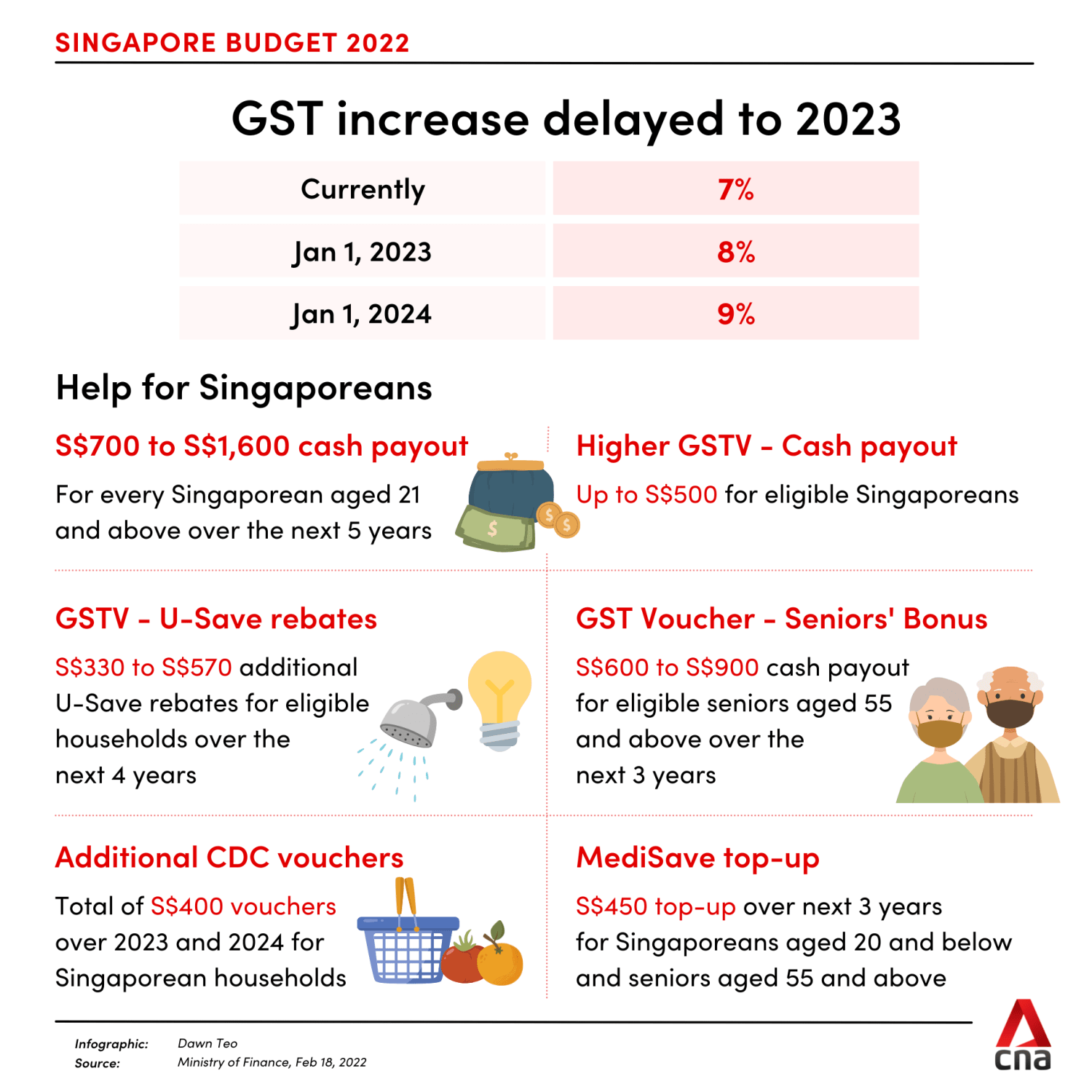
MORE SUPPORT FOR HOUSEHOLDS
Singaporeans will get more help with daily expenses through a S$560 million Household Support Package.
Under the package, GST Voucher – U-Save rebates will be doubled for the rest of the year, with eligible households to receive up to S$285 more.
Children aged 20 and below will receive a S$200 top-up in their education-related accounts.
Households will also receive another S$100 in CDC vouchers this year.
HIGHER CPF CONTRIBUTIONS FOR OLDER WORKERS
The Government will continue to raise employer and employee CPF contribution rates for older workers aged 55 to 70 in 2023, paired with a transition offset for employers.
The aim is to enhance their retirement adequacy, said Mr Wong.
A first increase was already implemented last year, in line with the recommendations of a tripartite workgroup.
This means older workers will see a total increase of 3 to 4 per cent in their CPF contribution rates over these two years.
To give retirees higher monthly CPF payouts, the basic retirement sum will also be raised by 3.5 per cent per year for the cohorts turning 55 from 2023 to 2027.
There is no requirement for members to top up their CPF if they are unable to set aside their basic retirement sum. But for those who do when they turn 55 in 2027, they will receive payouts of close to S$1,000 per month when they are 65, and this will continue for the rest of their lives.
TAXES RAISED FOR TOP EARNERS, PROPERTY, LUXURY CARS
Personal income tax rates for top earners will be raised to 23 per cent for the portion of chargeable income in excess of S$500,000 up to S$1 million, and 24 per cent for that in excess of S$1 million.
This is up from the existing 22 per cent.
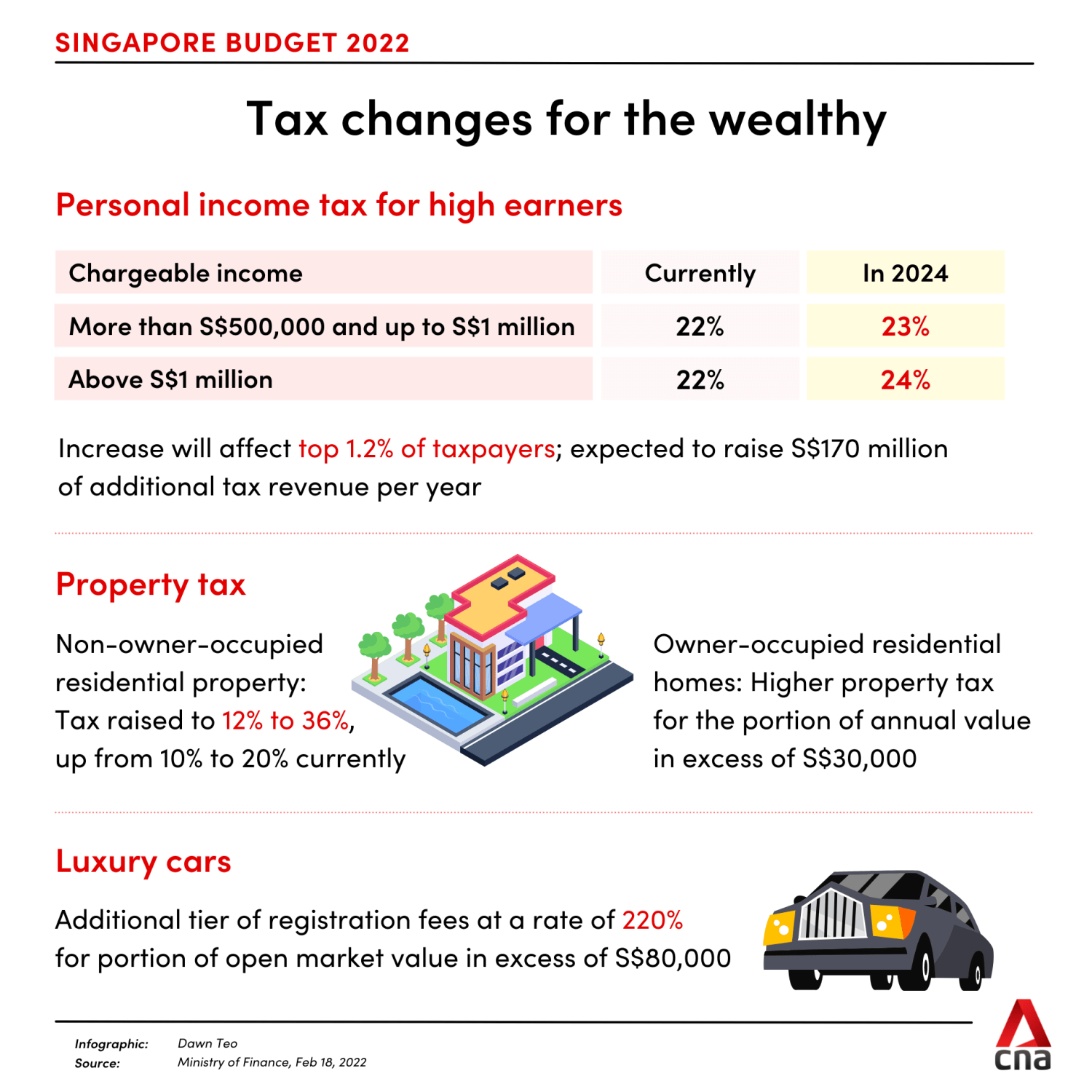
Property taxes, which Mr Wong described as Singapore’s “principal means of taxing wealth”, will also go up.
For non-owner-occupied properties, the tax rates will rise from 10 to 20 per cent currently, to 11 to 27 per cent in 2023, before going up further to 12 to 36 per cent in 2024.
Tax rates for owner-occupied properties with annual values of more than S$30,000 will also be raised. There will be a taxation range of 5 to 23 per cent beyond the first S$30,000 valuation by 2023, with a further increase to 6 to 32 per cent in 2024.
This increase will impact the top 7 per cent of owner-occupied residential properties, such as condominiums located in central Singapore and large landed properties.
Singapore will also start levying higher taxes on luxury cars to make its vehicle tax system “more progressive”, said Mr Wong.
NET ZERO EMISSIONS TARGET AND CARBON TAX
Singapore has set a more ambitious target of achieving net zero carbon emissions “by or around mid-century”, said the Finance Minister. This brings the timeline forward from “as soon as viable” in the second half of the century.
To achieve this new target, the Government will raise the carbon tax from the current S$5 per tonne of emissions to S$25 per tonne in 2024 and 2025. This will then rise to S$45 per tonne in 2026 and 2027, with a view to reaching S$50 to S$80 per tonne by 2030.
A transition framework will be put in place for businesses to ensure they remain competitive. Households, which may feel the pinch through higher utility bills, will also get additional support.
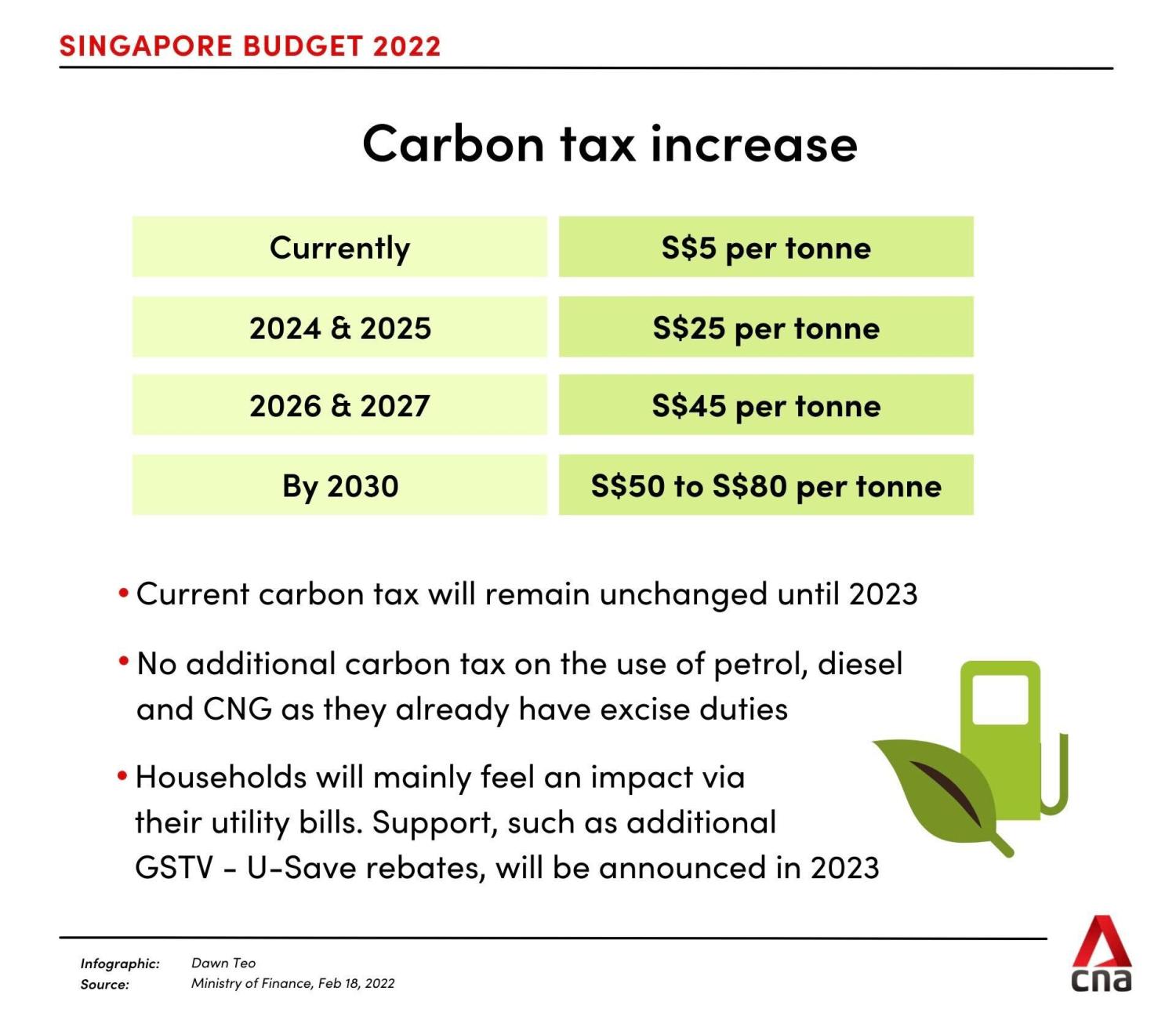
ELECTRIC VEHICLES AND GREEN BONDS
To accelerate the adoption of electric vehicles, more charging points will be built “closer to where we live”, said Mr Wong.
The Government aims to issue up to S$35 billion of green bonds by 2030 to fund such public sector green infrastructure projects.
This is part of efforts to develop a robust green finance market in Singapore and grab first-mover advantage in the green economy, added Mr Wong.
INVESTING IN DIGITALISATION AND INNOVATION
The pandemic has “turbocharged” the move to a digital future, and strengthening Singapore’s digital capabilities is one of the Government’s priorities to stay ahead in the race, said Mr Wong.
The Government will set aside S$200 million over the next few years to enhance schemes that build digital capabilities in businesses and workers.
Mr Wong also outlined plans to upgrade broadband infrastructure to increase access speeds by around 10 times over the next few years, and invest in future technologies like 6G.
MORE SUPPORT FOR BUSINESSES
Local employers will get immediate assistance from a S$500 million Jobs and Business Support Package.
This includes a new Small Business Recovery Grant for small- and medium-sized enterprises that have been most affected by COVID-19 restrictions, such as those in the food and beverage, retail, tourism and hospitality sectors.
They will receive a S$1,000 payout per local employee, capped at S$10,000 per firm. Local sole proprietors and partnerships in eligible sectors, SFA-licensed hawkers, market and coffee shop stallholders that do not hire local employees will also receive a S$1,000 payout.
In addition, the package covers a six-month extension of the Jobs Growth Incentive to support local hiring to Septmeber, although rates will be stepped down to reflect improved labour market conditions.
SUPPORT FOR LOWER-WAGE WORKERS
Consumers who want to support employers that voluntarily pay their workers progressive wages can look out for the new Progressive Wage Mark from March next year.
With more sectors set to be covered by the Progressive Wage Model in the coming years, the Government will introduce a Progressive Wage Credit Scheme to co-fund wage increases until 2026. This is to help employers adjust to the changes.
The Workfare Income Supplement will be enhanced in several ways. It will be expanded to younger workers aged 30 to 34, and the qualifying monthly income cap will be raised from S$2,300 to S$2,500. At the same time, a new income floor of S$500 will be introduced.
Maximum payouts under the Workfare will also be raised. For example, those aged 35 to 44 will be able to receive an annual payout of up to S$3,000, from S$1,700 currently.
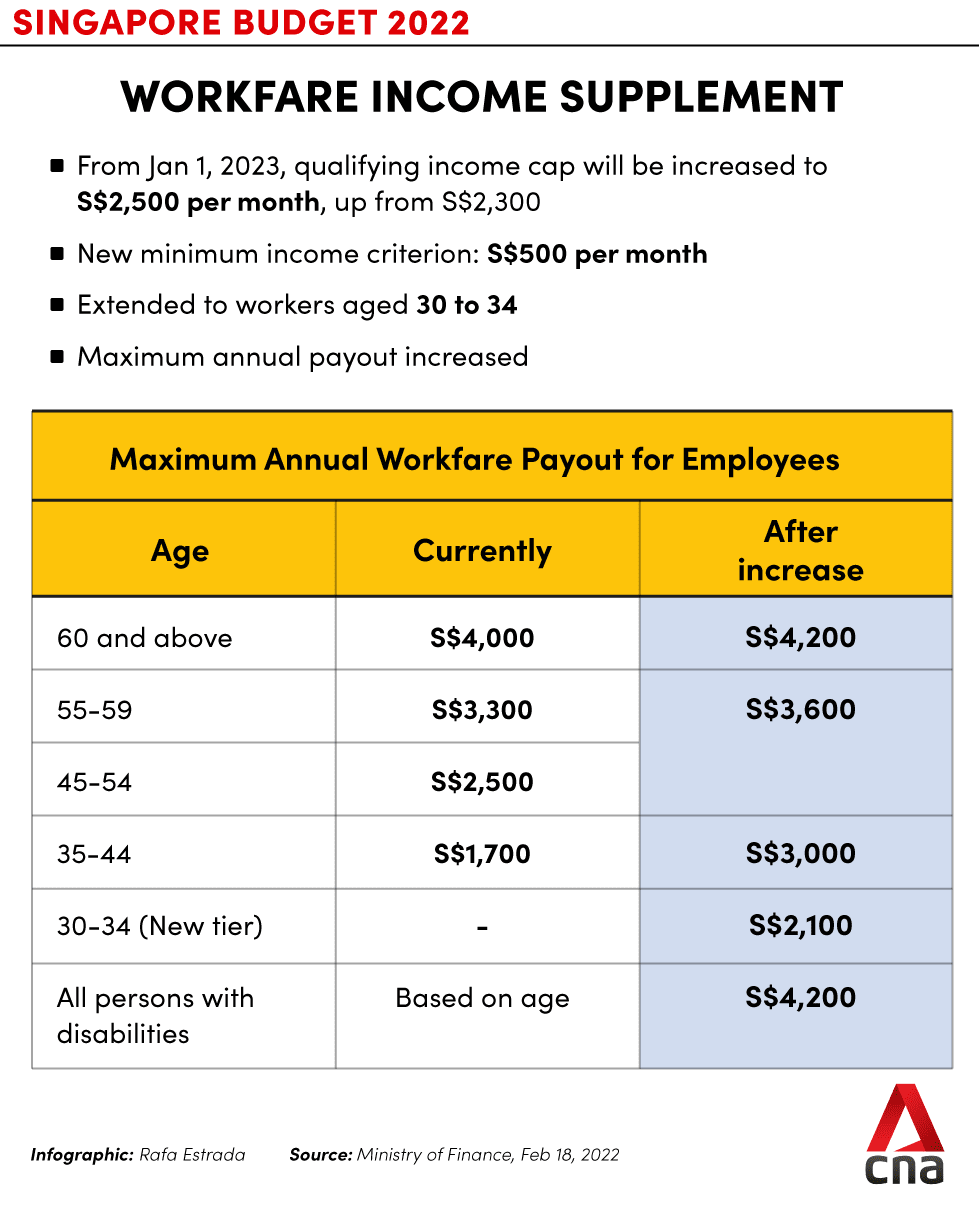
Watch the full statement here:





















